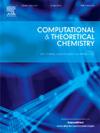Cd和惰性气体原子间的原子间键:分子间作用力的性质,加合物的稳定性,它们的光谱和热力学性质
IF 3
3区 化学
Q3 CHEMISTRY, PHYSICAL
引用次数: 0
摘要
本研究提供了由Cd和Ng(惰性气体)闭壳伴体相互作用产生的弱键加合物的基本特征。我们确定了整个Cd-Ng体系的势能曲线、光谱常数、寿命和热力学性质。得到的平衡距离、解离能和光谱常数与实验数据非常吻合,证明了所选方法的准确性。还观察到分散项是Ng-Cd加合物形成的主要因素。此外,寿命分析表明,这些加合物一旦形成,在200 ~ 500k之间保持稳定。该研究还表明,Ne-Cd和Kr-Cd体系表现出倒置的振动分布,这表明这些加合物可能与激光开发等应用有关。这项工作代表了表征控制物质静态和动态特性的弱相互作用的重要一步。本文章由计算机程序翻译,如有差异,请以英文原文为准。

The interatomic bond between Cd and noble gas atoms: The nature of the intermolecular forces, the stability of the adducts, their spectroscopic and thermodynamical properties
This study provides fundamental features of weakly bonded adducts arising from the interaction of the Cd and Ng (noble gas) closed-shell partners. We determined the potential energy curves, spectroscopic constants, lifetimes, and thermodynamic properties for the entire family of Cd-Ng systems. The obtained results for equilibrium distances, dissociation energies, and spectroscopic constants show excellent agreement with experimental data, demonstrating the accuracy of the chosen methodologies. It was also observed that the dispersion term is the dominant contributor to the formation of the Ng-Cd adducts. Moreover, the lifetime analysis indicates that these adducts remain stable between 200 and 500 K once formed. This study also reveals that the Ne-Cd and Kr-Cd systems exhibit an inverted vibrational population distribution, suggesting that these adducts may be relevant for applications such as laser development. This work represents an important step in characterizing the weak interactions that govern matter’s static and dynamic properties.
求助全文
通过发布文献求助,成功后即可免费获取论文全文。
去求助
来源期刊

Computational and Theoretical Chemistry
CHEMISTRY, PHYSICAL-
CiteScore
4.20
自引率
10.70%
发文量
331
审稿时长
31 days
期刊介绍:
Computational and Theoretical Chemistry publishes high quality, original reports of significance in computational and theoretical chemistry including those that deal with problems of structure, properties, energetics, weak interactions, reaction mechanisms, catalysis, and reaction rates involving atoms, molecules, clusters, surfaces, and bulk matter.
 求助内容:
求助内容: 应助结果提醒方式:
应助结果提醒方式:


